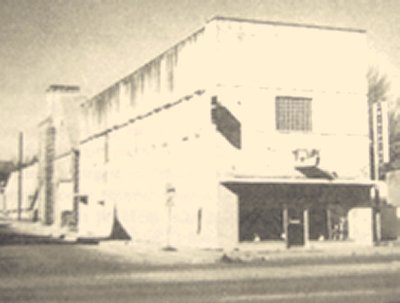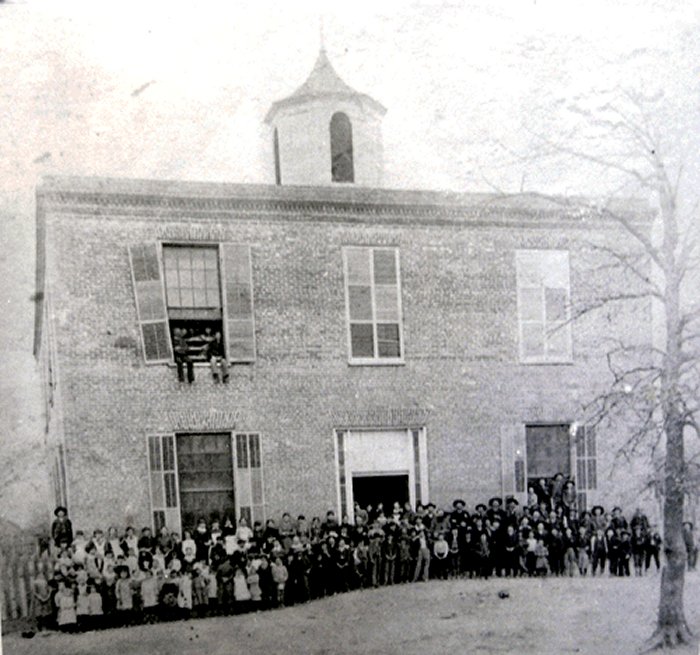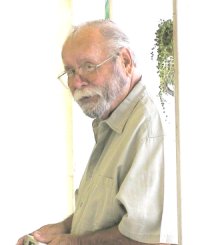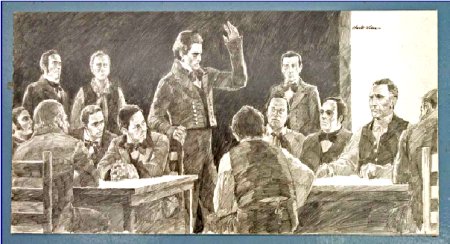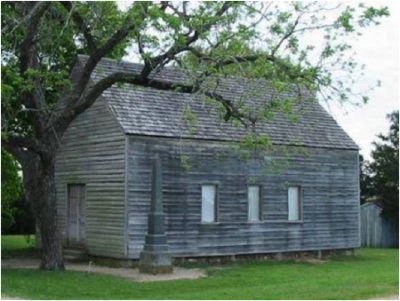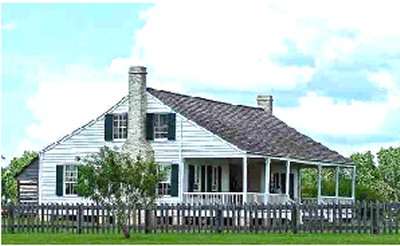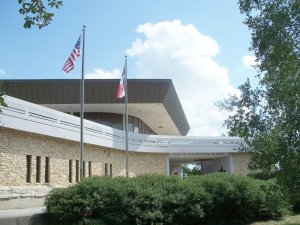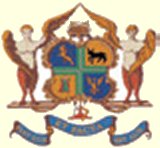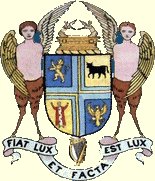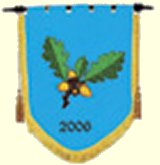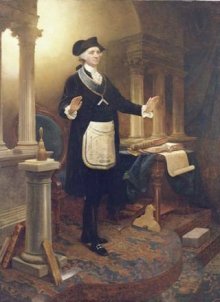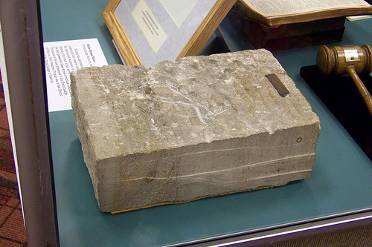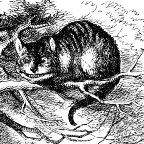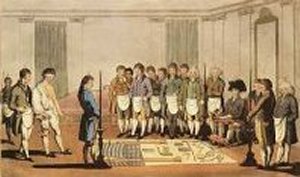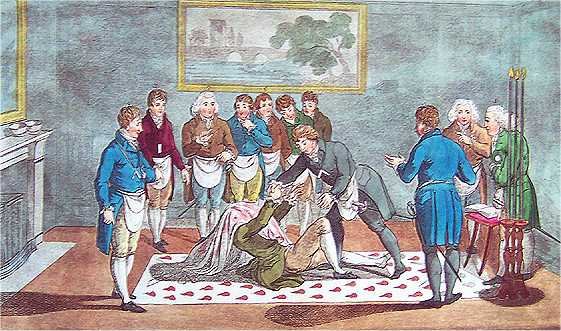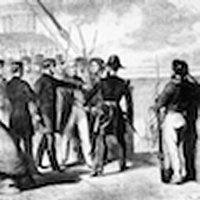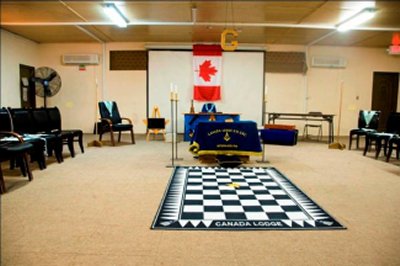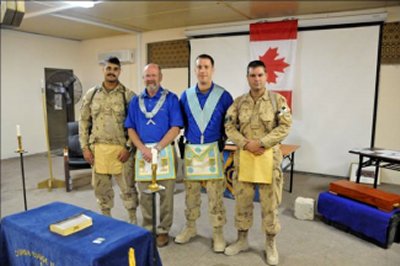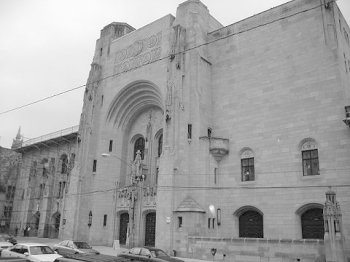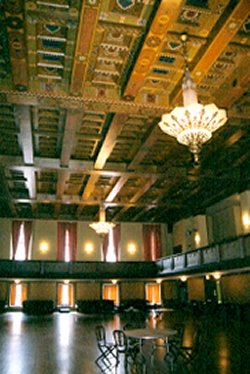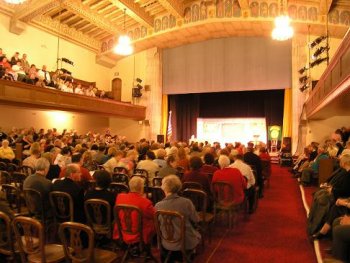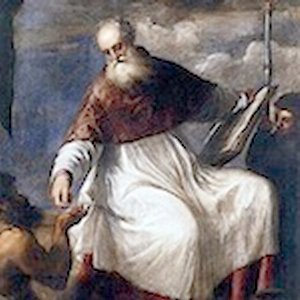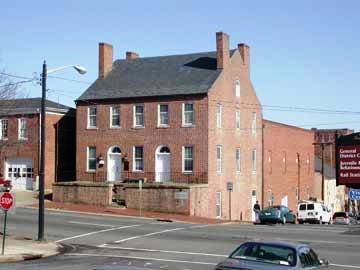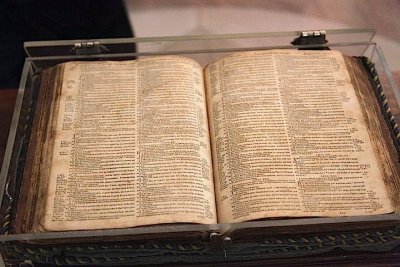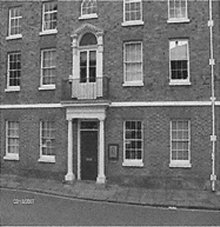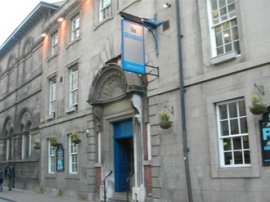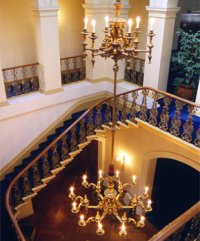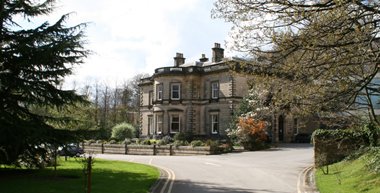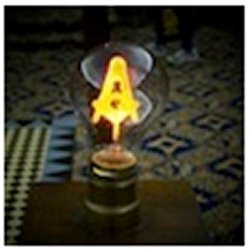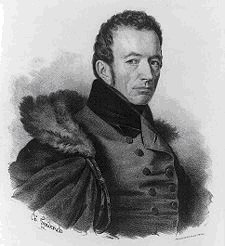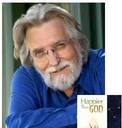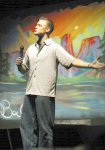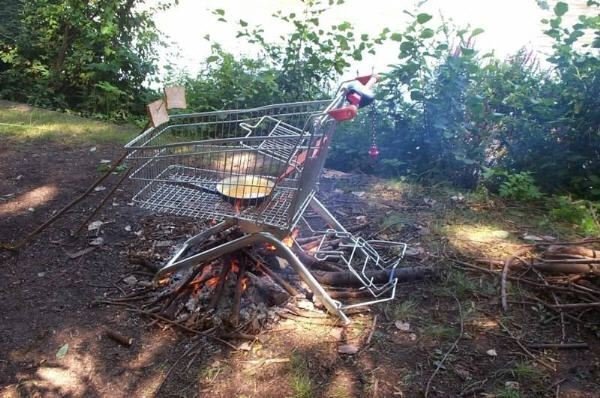
|
February 2011

Phoenix Masonic Lodge #275 A.F & A.M
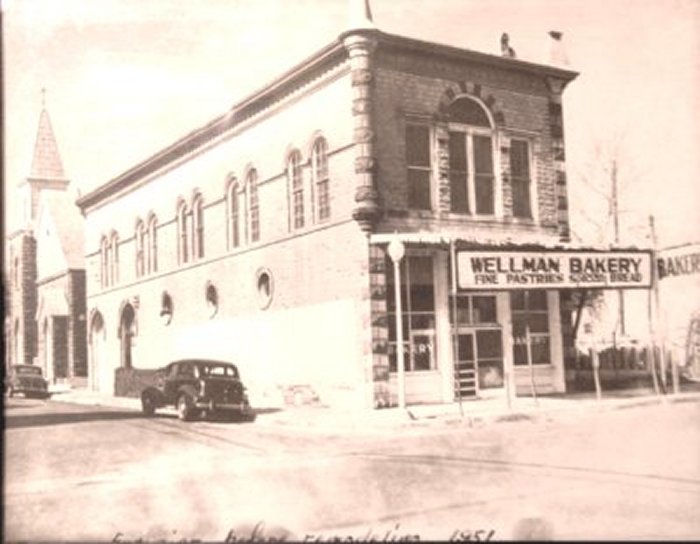 Front street view old lodge before remodel around 1951. |
|
| ||||

Parker County was created in 1855 and by 1858 there was enough interest in Weatherford for Masons to request a dispensation from the Grand Lodge of Texas. The names on the petition were A.F. Corning, Edwart T. Balch, Robert P. Baker, G.W. Wilson, James A. Cahill, John R. Fondren, R. Willis Duke, John Deavours and W.B. Fondren. The request for a dispensation was accompanied by a letter from Walnut Creek Lodge #205 which was dated December 18, 1858. The letter recommended A.F. Corning as Worshipful Master, E. Calch as Senior Warden, and Robert P. Baker as Junior Warden. They described as being "competent suitable persons to confer the degrees of E.A., F.C., and Master Mason according to our ancient rules and customs." The letter went on to note that the new lodge would be more than ten miles away from the nearest lodge. The recommendation had received a unanimous vote and the letter was signed by R.J. Billingsley, Secretary and T. Short, W.M. The recommendation was accepted and dispensation was granted on January 15, 1859. The dispensation recognized Corning, Balch and Baker as the principle officers and was signed by Grand Master Henry Sampson.
Ocean Lodge U.D.(under dispensation) met from January to June of 1859. In a brief report submitted by J.N. Reed, eight lodges including Ocean Lodge were recommended to the Grand Master. The charter was granted in June of 1859 and was signed by Grand Master James F. Taylor. The annual report filed on December 27, 1859 contains a summary of the Lodge's acctivities from July to December
29 Master Masons @ $.60 $17.40
The returns also reported that they were meeting on the 2nd and 4th Saturdays and that three petitions had been rejected. The officers for 1860 remained the same except for Robert P. Baker, the Junior Warden, who was replaced by John W. Squyres.
In 1862 a Mason by the name of H.A. Hamner who was a initiated by Relief Masonic Lodge was wanting receive his Fellowcraft, and Master Mason degree's to join Ocean Lodge. A petition was read during Relief Lodge stated meeting to let Ocean Lodge pass and raise brother Hamner. The petition was denied with four dissenting votes. On March 4, 1862 the request was renewed. The Master of Relief Lodge refused the request "in positive terms" and left the lodge hall to prevent them from opening the lodge. He returned later in the evening and was informed by the Junior Warden that the lodge had been opened and an order had been passed granting the request. He later learned that the brethren of Ocean Lodge had conferred the degrees upon brother Hamner. The report of the committee on Grand Officers' Reports is found in the 1862 proceedings. They felt that Relief Lodge had "purged itself by dealing with and punishing the offending members." They did express a regret that the Master of Relief Lodge had failed to take the charter with him when he left the lodge hall. They felt this would have prevented the other brethren from trying to open a lodge in his absence. Apparently, Ocean Lodge had made no attempt to punish the offenders. The committee recommended that the District Deputy be instructed to arrest the charter of Ocean Lodge. This recommendation was accepted by the Grand Master and DDGM John Matlock was so instructed. Since the last meeting of Ocean Lodge as in May of 1862 the order must have been carried out immediately. The Grand Lodge Proceedings for 1864 recorded that the charter was returned to the Grand Lodge in 1863 and that the jewels and furniture of the lodge had been donated to Phoenix Lodge U.D. which was set to work in June of 1863.
In Greek mythology the Phoenix was a bird which destroyed itself by fire every 500 years. From the ashes would rise a new Phoenix with renewed strength and beauty. The symbolism of the Phoenix was also appropriate for the situation which existed among Masons in Weatherford, Texas, in 1863. Several of the brethren who were members of Ocean Lodge were among those who petitioned the Grand Lodge for a dispensation to form a new lodge in Weatherford. They chose a most appropriate name as Phoenix Lodge rose out of the ashes of Ocean Lodge and was set to work under dispensation in June of 1863.
The letter for dispensation to form a new lodge was signed by O.W. Keeler, D.O. Norton, H.M. Norton, Eli Baum, R.L. Porter, L.D. Conger, D. Ford, J.D. Beckwith, T.K. Baily and J.A. Fain. The petition was granted and Phoenix Lodge U.D. was formed on June 27, 1863. This revival of Masonry in Weatherford came in the midst of turbulent times. Te Civil War was near a major turning point. The value of The most notable of these brethren were Oliver Loving, a prominent cattleman and merchant; O.W. Keeler, Weatherford's first schoolmaster who had been secretary of Ocean Lodge and became the first Master of Phoenix Lodge; John Deavours, who became secretary of Phoenix Lodge during its year under dispensation; J.H. Prince, one of the original settlers, and D.O. Norton, one of the first alderman of Weatherford. Another member, F.A. Leach, later became Master of Phoenix Lodge and was the first elected High Priest of Weatherford Chapter #105 which was chartered in 1872. Judge Leach also played a major role in aiding Phoenix Lodge with its economic problems incurred in connection with building the Weatherford Masonic Institute in 1869.
At the initial meeting on June 27, 1863 O.W. Keeler served as Worshipful Master and appointed the following officers. D.O. Norton, Senior Warden, H.W. Horton, Junior Warden, Eli Baum, Sect, R.L. Porter, Treas, J.A. Fain, Senior Deacon, T.K. Bailey, Junior Deacon and J.D. Beckwith as Tyler. Other brethren present at this meeting were L.D. Conger of Phoenix Lodge, J.A. Smith of Waxahachie Lodge #60, L.B. Smith of Rocky Mountain Lodge #90 and J.M. Luckey of Walnut Creek Lodge who served as Junior Deacon pro tem for this meeting. During the one year existence of Phoenix Lodge U.D. there were 76 petitions, 23 of these were petitions for affiliation, with 18 being approved and 5 rejected. 53 were for degrees with 31 being approved and 22 rejected. The petitions approved resulted in 23 E.A.'s 22 F.C.'s and 16 Master Mason degrees. The first stated meeting of Phoenix Lodge U.D. took place on July 25, 1863. This was a very special occasion for Oliver Loving, who was later to join Charles Goodnight in becoming a frontier legend. Loving presented his petition for affiliation and [Editor note; Sentence ended here on the original.]
From the very beginning Masons were involved with education in Parker County. The earliest settlement in the county was founded by Captain W.G. Veal who was a Methodist minister and leading Mason. He moved there in 1852 and organized it into a community known as Veel's Station in 1858. The church aso served as a school. The Masonic Lodge there operated from the 1860 to 1873. The First Public school in Weatherford was operated by O.W. Keeler who served as the first secretary of Ocean Lodge No. 230 and as the first Master of Phoenix Lodge No. 275. The September 13, 1860 issue of The White Man carried a notice which said "Pleased to state the services of Mr. R.A. Hawkins have been secured for our institute and now Mr. Keeler is prepared to take a few more scholars. Classes were conducted in a blacksmith shop with a dirt floor, and split log benches. He was also assisted by Mollie Dryer who later married Charles Goodnight.
The Weatherford Masonic Institute.
The initial fund raising drive produced $8,000 and work began on the building in April of 1869. The cornerstone was laid on July 5, 1869. District Deputy Judge J. Matlock was in attendance with the local brethren specially deputized to serve as Grand Officers for the occasion.
|
|
| |
Continued From Page III
The annual Fourth of July celebration and the July 5th ceremonies were both marred by indian "depredations." A band of eleven Indians were raiding nearby ranches and were able to accumulate a herd of more than 500 horses.
Despite a very optimistic beginning the lodge was soon beset with financial problems that would last for the next twenty years. The actual cost of the building was $15,000 rather than $12,000 and work stopped in 1870 without the interior being furnished. In 1870 the lodge ased the Grand Lodge to remit their annual dues. The Grand Lodge reply was quite complimentary but the request was denied. In 1870, Judge F.A. Leach, a past Master of Phoenix lodge, personally raised $850 to make the highest bid when the school and property was auctioned off by the sheriff to pay its indebtedness. Leach then secured a loan of $850 for the lodge and transferred the title to Phoenix Lodge. At a meeting of Phoenix Lodge on September 27, 1873 a motion was approved to assess each member $5 in order to raise $850. At the November 22, 1873 meeting Judge Leach reported that he was about to negotiate a loan at 2 1/2% per month. At the December 27, 1873 meeting the lodge was called from labor to refreshment to solicit contributions to pay off the indebtedness of the Weatherford Masonic Institute. In January of 1875 the lodge leased the building to the Weatherford High School Association for 10 years with the express understanding that the school should never be sectarian in character, under forfeiture of lease. This new arrangement did allow the lodge to gain a clear title by 1877 but did not end its financial problems in connection with the building. After leasing the building for 10 years the lodge informed the school board that the lease would not be renewed because the building is being damaged and that it. This new arrangement did allow the lodge to gain a clear title by 1877 but did not end its financial problems in connection with the building. After leasing the building for 10 years the lodge informed the school board that the lease would not be renewed because the building is being damaged and that it and that it cost a good deal to keep the building in repair. The lodge then sold the building and property to Brother M.C. Brown for $3,000 which was to be paid out at $25 a month. New property was purchased and at a called meeting on September 19, 1885 the lodge was convened for the purpose of laying the cornerstone of the new college building. In January of 1887 the Methodist Church asked to be released from the rental agreement because the church had suffered the destruction of its own building. The committee appointed a investigate the request reported at the January 8, 1887 meeting of the lodge. They recommended that the request be denied because: 1. The proposition was to go on indefinite. 2. The building was rented in good faith. 3. It was too late in the school year to rent it to anyone else. 4. If the situation was reversed and the lodge had the chance to rent it for $50 a month the church would hardly release the lodge from the original lease. The final vote was 6 to 6 with the Master of the lodge casting the deciding vote to deny the request. In 1888 the lodge sold their new lodge hall for $2,500 to be paid out in three years. At a meeting on June 8, 1889 they approved the sale of the original school and property. The new owners then worked out an agreement ot move Granbury College to Weatherford. The main collge building at Granbury had been destroyed by fire. An agreement was worked out for the faculty and the library of the college to be moved to Weatherford and Weatherford College opened its doors for its first session on September 15, 1889.
On August 16, 1890 the cornerstone was laid for the current lodge building at the corner of South Main and Oak Street. This marked the end of the first 25 years for Phoenix Lodge and the end of the Weatherford College. | |
|
From: John Daut
I wanted to send you a copy of a letter I wrote a couple of years ago. I believe you will understand, and if it or any part can be used it's OK.
To; Mr Wheeler Neil Daut
Do you remember how excited you were when you became a Freemason way back in the 1940's? I still do. Your enthusiasm for attending Lodge meetings always let mom and I know how much enjoyed your Lodge and the fellowship of your brother masons.
I remember how excited you were when you were raised to the Master Mason's degree and how you rushed home that night with your white lambskin apron. Somehow, the idea of being excited about something for you to be buried with, escaped me at the time.
I remember how excited you were when you went into the Scottish Rite and came home to tell us that you were now a 32nd. degree Mason. You bought a 32nd. degree ring and wore it with pride. You even bought the 2 volume set of Mackey's Revised Encyclopedia of Freemasonry to learn more about the craft. I guess I always knew that you wanted me to become a mason, but somehow I always fought against the idea. People (non masons) always told me, "Hey, if you're one of them Masons, you got it made. You can really go up in the world, get promotions and everything." Somehow that always turned me off. I guess I was young and had ideals. I wanted to get ahead on my own, without someone giving it to me.
In 1960, in the first job I had with the City of Houston, a new supervisor (a Mason) reassigned me to work in his office and used my expertise about the department and my abilities to revise the operation of the department. After the work was finished and he had the credit for the increased efficiency, I was reassigned back to the streets and the supervisor brought the only Mason in the department to work on the inside. It not only hurt, but it proved to me that "those people" were right.
By 1974, I had long since transferred to a different department and been promoted first to a foreman, then to the supervisor over 90% of the department. My supervisor, a Mason, had promoted me over the Masons in the department. This changed my views on Masonry and I filled out a petition for the Mysteries of Freemasonry that year. As you probably know, for various reasons (including money) I kept delaying and never turned it in.
After your oldest grandson, John Neil became a Mason in 1990, I could see the same excitement in his eyes that I used to see with you. His eyes asked why aren't you a Mason dad? The answer was simple. Hey, I'm in sixty four years old, and it's to late for me to start something like that. But, I was still interested and read a number of books including "Born In Blood". I was very impressed by what I read.
Sometime afterward your youngest granddaughter, Becky, got married, I asked her husband Pete why he hadn't ever became a Mason. His answer was simple, no one had ever "asked him to join". I did know enough to know that he would never be asked. For some reason I took it upon myself to convince him that he should think about becoming a Mason. That's when he pulled the big one on me. "I will if you'll go in with me," he said. What better way could I help my daughter and her husband through life than by saying OK...
John was overjoyed when I asked him to get petitions for Pete and me. I know now that you would have been also, if I had asked you.
Anyway, that's what I wanted you to know, I was raised to a Master Mason in the Cedar Bayou Lodge #321 AF & AM in December 1992, 3 months before my 65 birthday. Then the next July, I went through the Scottish Rite and received the 32nd. degree. Not to long after that, I was initiated into the Shrine. And, not to long after that I also joined the Humble Lodge #979 AF & AM. as a plural member.
I have to admit that when I started learning the work as an Entered Apprentice, it was just a bunch of words that I had to learn to get through the degrees. By the time I begin learning the Master Mason's work, it happened to me. Somehow, as we progressed, the words grew into sober-minded concepts and those concepts evolved into an inspiration for a new outlook on life. Now I wish it could have been at the Cade Rothwell Lodge, with you, those many years ago, but somehow I think maybe you know that.
Your Son and Belated Brother in Masonry
John W. Daut
|
|
| ||||||||
|
Washington On The Brazos The Birthplace Of Texas
In 1821 Andrew Robinson and his family joined Stephen F. Austin's colony and made their new home on the west side of the Brazos River at the La Bahia crossing. The old Spanish road between Goliad and East Texas had been in use since the 17th century, the Robinsons were the first permanent settlers at the crossing. Robinson farmed, raised livestock and operated a ferry. In 1835 John Hall purchased the property from Robinson, his father-in-law, and formed the Washington Town Company. Hall's partners in the enterprise were Asa Hoxey, Thomas Gay, Alexander Somervell and James B. Miller. The town was laid out near the ferry landing and lots sold at a public auction in Washington on January 8, 1836. The name "Washington-on-the-Brazos" was used to distinguish the settlement from "Washington-on-the-Potomac". The area that became known as Washington County began as a Mexican municipality located near the center of Stephen F. Austin's first colony, the area was opened to settlement in 1821 under Spanish control. It is one of the earliest settled areas in Texas. Spurred by the liberal land grants, settlers from all parts of the United States and immigrants from Western Europe gathered in the colony. The first cabins with their crops of necessity, such as corn, peas and tobacco patches, grew into ranches, plantations and farm settlements. The early city of Washington-on-the-Brazos was started in 1821. It developed and flourished with steamboat navigation on the Brazos River until the coming of the railroads in 1860-1880.
Often overlooked is the courage and determination of the delegates as they worked while facing the same fear and consequences that loomed over the men who labored for American independence from the British. They knew the desperation of Travis and his men located in the Alamo in San Antonio. They received word of his dire circumstance twice during the Convention. The Alamo was only a few days' march from where they convened, and rumors that Santa Anna was just down the road kept them on edge. On March 15, news of the fall of the Alamo finally reached the delegation in Washington. One delegate had lost a son at the Alamo, another a brother. The men remained diligent to their task, though heartbroken, weary and fearing an invasion by enemy troops. For two more days the worked tirelessly, finally electing the new country’s government officials. The delegates worked until March 17, when they had to flee, along with the people of Washington, to escape the advancing Mexican Army. The townspeople returned after the Mexican Army was defeated at San Jacinto on April 21. Town leaders lobbied for Washington’s designation as the permanent capital of the Republic of Texas, but leaders of the Republic passed over Washington in favor of Waterloo, which later was renamed Austin. The eighth Masonic Lodge in Texas, Temple Lodge #8 was chartered at Washington. A large number of the early Texas leaders who lived or were visitors to Washington were Freemasons. Masonic membership was often the one common denominator among the early settlers and adventurers that came to Texas in the early 1800's.of different backgrounds and cultures often found a hearty welcome in the "friendly grip" of a brother Mason's handshake.
It is now one of the best documented and laid out ghost town. Aside from the reconstruction of the hall where the Texas Declaration of Independence was signed (guided tour available), the old streets of the once-thriving but now mostly vanished city are marked. Standing on the main street, you can see outside of the park to where the main road linked up, leading to the old ford of the Brazos River. The State of Texas purchased 50 acres of the old town site in 1916 and built a replica of the building where the delegates met. The state acquired more of the site in 1976 and 1996.
There is an excellent museum and visitor center and a gift shop. Go there any time of the year and you'll have almost the whole place to yourself! Beautiful views of the Brazos, particularly in the fall, and the tall, old pecan trees are lovely. There is still a city of Washington outside the park, with a post office and one or two other buildings. In Houston, Washington Avenue was named after Washington-on-the-Brazos. It was the western route to Washington County. Following the present day road: Washington Avenue; Hempstead Highway; US 290 (Northwest Freeway) then outside of Harris County US 290 is called Houston Highway.
Compiled from Wikipedia, Wapedia, Ghosttowns.com, Texas State Library and Archives Commission, Welcome to Washington County Texas, and the Grand Lodge Of Texas website by John “Corky” Daut, P.M. Waller Masonic Lodge #808 AF & AM
| ||||||||
|
| ||
Both Kerry and Bush were members of "Skull-and-Bones", so when they ran for USA-Presidency against each other, it was not the USA-People who decided the winner, but the "secret-code" of that elitist sect.
Similarly, USA-Freemasonry decides USA-Elections.
Voting is irrelevant, Democrats are the same as Republicans, controlled by their masonic forces.
Benjamin-Franklin at age 28 was nominated "grand-master" of the masons in Pennsylvania. He then re-printed the bible, the constitution of USA-Freemasonry, "The Constitutions of the Free-Masons".
At the end of the USA-Revolutionary-War all the provincial masonic "grand-bodies" set themselves up as independent "grand-lodges", according to the USA-masonic-doctrine of "exclusive-jurisdiction". Each grand-lodge is sole and sovereign in "masonic-matters" within its own "acknowledged-territory", and any "invasion-of-territory" is grounds for discontinuing "fraternal-recognition".
Gods, bibles, no talking politics, no talking religion, those are the four pillars of the USA-Freemasonry, and the USA-Freemasonry has effectively and visibly succeeded imposing those rules onto all USA workplaces and all USA schools, colleges and universities (fraternities and sororities).
In 1912 a George-Washington-Masonic-National-Memorial was erected in Alexandria, VA, under a masonic cooperative undertaking that reunited in an annual conference the grand-masters and the "grand-lodge-secretaries". Another freemason "national-body" in the USA is the Masonic-Service-Association, headquartered in Washington, DC, with "national-functions" of "service-relief-education".
"Masonic-degrees" with or without organizational form include monarchical "royal-arch-degree", conferred by "master-masons" or by "lodge-authority", and "royal-arch-chapters" are coordinated in the aristocratic exclusive elitist "capitular-rite", reflecting Brittish-monarchy-style ideas and ideals, with degrees of nobility and an established secret-gotha all the way up to a "royal" kingdom. The "capitular-rite" confers four degrees, "mark-master", "past-master-virtual", "most-excellent-master", and "royal-arch", and the chapters are governed by "grand-chapters" and a "general-grand-chapter", with all applicants being master-masons in "good-standing".
The "knights-templar-degree" is conferred by "local-commanderies", formed under the "grand-general-encampment" of "knights-templars" and the "appendant-order-grand-encampment", where the point of entrance is the local-commandery, with all applicants being "royal-arch-masons" in good-standing. The "commandery" confers three orders, "red-cross" – not linked with the Red-Cross, "knights-of-malta", and "knights-templar", and is governed by "grand-commanderies" under the "grand-encampment" of the "templar-rite".
The "scottish-rite" confers the orders of monarchical "royal-masters" and "select-masters", governed by "grand-councils" and a "general-grand-council-cryptic-rite".
The "york-rite" encompasses the "bodies" of the capitular, cryptic, and templar rites, and as the knights-templar is the "culminating-degree" of the york-rite, the "cryptic-rite" follows the capitular and preceds the templar "degrees". The "cryptic-degrees" are not a requirement for applicants in the commanderies.
The masonic "grand-constitutions", sanctioned by the German Fascist Emperor Frederick-the-Great, himself a freemason, provides for "supreme-councils" to govern the scottish-rite in the USA. A "supreme-council" is the "parent-body", elects its own members, and is self-perpetuating. Unlike the "grand-bodies" of the york-rite, a supreme-council is not composed of representatives from the subordinate-bodies, but it charters the subordinate-bodies, namely "lodge-of-perfection" (conferring the 4th through 14th degree), "chapter-of-rose-croix" – linked with the German Shaman Christian-Rosenkreuz (conferring the 15th through 18th degree), "council-of-kadosh" – linked with the Israelite-Holiness (conferring the 19th through 30th degree), and the "consistory" (conferring the 31st and 32nd degrees). The supreme-council confers the 33rd degree, and the supreme-council itself is composed of active 33rd-degree masons, and each of these masons is the "highest-officer" of the scottish-rite in his respective "orient".
Among the plethora of "appendant-orders" of the first three degrees are "blue-lodges", 'international-order-of-the-eastern-star", "ancient-arabic-order-of-nobles-of-the-mystic-shrine" (seemingly anti-constitutional, as orders of nobility are prohibited), "royal-order-of-scotland" (seemingly anti-constitutional, advocating a foreign monarchy), "the-red-cross-of constantine" – linked with the Roman Debauched Emperor Constantine-the-Great, "the-mystic-order-of-veiled-prophets-of-the-enchanted-realm" [sic] – seemingly shamanic, "the-tall-cedars-of-lebanon", "the-order-of-de-molay" – linked with the French freemason grand-master Jacques-de-Molay, who had tried to create an alliance between France and Mongolia against the Egyptian Mamluks, and who was later burnt at the stake.
The freemason historian JSM-Ward describes some ceremonials of initiations into secret societies:
the ceremony comprises four sections:
first – the traditional history is given to the candidate in the anteroom before he enters the lodge, and it is a moving story where a group of people help an emperor, and only three survive, and they became the founders of the "order"
second – the candidate is "prepared" in the anteroom, with ceremonial washing, changing into white robes (leaving bare the right arm, shoulder, breast, and knee), and putting on slippers
third – the actual admission of the candidate, who has to pass through three gates inside the lodge and take the oath of "blood-brotherhood" by mingling his blood with that of all members present in a cup of wine, from which each person present drinks
fourth – "catechism" of the "master" asking a series of questions, which a "conductor" answers for the candidate: these revealed that they had been on a long and mysterious journey, first by land and then by boat, and throughout the whole of this part of the ceremony great stress is laid on numbers, which have a definite mystical significance, like the Israelite-Kabbalah.
… this content is in the form of a DRAFT, so please comment for modifications …
Feel free to copy this page and email it to family, friends, and colleagues.
No copyrights. No rights reserved. This material is not copyrighted, trademarked, registered, or otherwise protected in any form or manner. No rights reserved at any time or in any manner in any country or territory. All information herein can be freely quoted, copied, reproduced, and reprinted, even in parts, and even without mentioning the author or the source.
| ||
|
| ||||
 Grand Lodge of Ireland
The Grand Lodge of Ireland is the second oldest in the world and the first evidence for its existence comes from the Dublin Weekly Journal of June 26th 1725. The paper describes an event which took place two days previously on June 24th - a meeting of the Grand Lodge of Ireland to install the new Grand Master, the 1st Earl of Rosse. Unfortunately the exact date of the foundation of the Grand Lodge is not known, but the installation of a new Grand Master would suggest it was already in existence a couple of years. 1725 is the year celebrated in Grand Lodge anniversaries.
There is considerable evidence that there were Masonic Lodges meeting in Ireland prior to the eighteenth century, for example the manuscript known as "the Trinity Tripos" dating to the 1680s, and the Baal's Bridge Square, discovered in Limerick in the mid nineteenth century, which purportedly dates to the early sixteenth century. The story of the "Lady Freemason", Elizabeth St. Leger, also dates to a time prior to the existence of the Grand Lodge.
During the eighteenth century hundreds of Lodges were founded in every part of Ireland, and most of these would have met at inns, taverns and coffee houses. In Dublin, Lodges were known to have met in the Yellow Lion on Werburgh Street, the Centaur Tavern on Fishamble Street, and the Eagle Tavern on Cork Hill, amongst others, and in Belfast meetings were held in the Sailor on Mill Street and the Donegall Anna. The meetings of the Grand Lodge however, generally took place in civic and guild buildings such as the Tailors' Hall in Back Lane, the Cutlers' Hall in Capel Street, and the Assembly Rooms on South William Street.
Towards the end of the eighteenth century the number of new Lodges being founded increased dramatically at the same time as the popularity of the Volunteer Movement expanded. Several Lodges were associated with Volunteer Regiments, and in Dublin, the First Volunteer Lodge of Ireland No. 620 was founded by the Officers of the Independent Dublin Volunteers in 1783. The Ballymascanlon Rangers were associated with Lodge No. 222, Dundalk, and in Fermanagh there was a regiment known as the Lowtherstown Masonick Volunteers,
The political influence of the Volunteers combined with the success of the American War of Independence and the French Revolution created new ideals of democracy in Ireland. Following the founding of the Society of United Irishmen several Lodges, particularly in the north of Ireland, made public proclamations in the press about the need for reform of the Constitution. Whilst the vast majority of Lodges that did this disavowed violence as the means to an end, some were quite rebellious in their proclamations. Other Lodges, it must be said, publicly dissociated themselves from their more revolutionary Brethren.
Government pressure was brought to bear on Grand Lodge and notices were sent out reminding Lodges of the Grand Lodge Law forbidding quarrels of a religious or political nature to be brought within the doors of the Lodge. However, several well-known United Irishmen including Henry Joy McCracken, Henry Monroe, and Archibald Hamilton Rowan were also Freemasons.
In 1826 the papal Bull of Leo XII against secret societies was widely promulgated in Ireland unlike the previous bulls issued against Freemasonry in the eighteenth century. Catholic members of the Order were threatened with excommunication if they failed to resign from their Lodges. One of the most prominent figures in Irish history to have been a Freemason, Daniel O'Connell, resigned after pressure was put on him by Archbishop Troy of Dublin.
The nineteenth century saw the expansion of Irish Freemasonry to all four corners of the globe with Lodges established in Australia, New Zealand, the West Indies, India and the Far East. Prominent during the century was the 3rd Duke of Leinster who presided over the Order as Grand Master for an impressive sixty one years. The nineteenth century also saw the expansion of the Masonic Female Orphan School, founded in 1792 to educate the daughters of deceased Freemasons. In 1881 a brand new school building was opened on the Merrion Road in Dublin while in 1867 the Masonic Orphan Boys School was founded.
By the 1820s the Grand Lodge of Ireland had arranged to lease No, 19 Dawson Street, Dublin, for use as the headquarters of Irish Freemasonry. From there, following a brief sojourn in the Freemasons Coffee House in D'Olier Street, the Order moved to another rented premises, Commercial Buildings on Dame Street, which became the Masonic Hall until 1869 when the present Freemasons' Hall opened for meetings. The new building was designed and purpose built as a Masonic Hall and it remains the headquarters of Irish Freemasonry, housing dramatically decorated Lodge rooms, a library. a museum, offices and dining areas.
| ||||
|
| |||
Author Brad Meltzer is host of the syndicated TV Show.
Here's my favorite story about the White House: On 13 October 1792, stonemasons laid the cornerstone for the White House -- the first government building in Washington DC. The men who placed it were brothers in one of the world's most secretive organizations -- you guessed it -- the Freemasons, who attached a brass plaque to the stone, staged an elaborate Masonic ceremony, and lowered it into place. Sounds like the set-up for a thriller, yes? But it's all true. And within twenty-four hours, the stone supposedly went missing. No one knows where it is. Harry Truman went looking for it during the construction that led to the Truman Balcony. Barbara Bush supposedly also went looking for it when they celebrated the anniversary of the building. It still hasn't been found.
Some say the cornerstone was inscribed by our Founding Fathers -- others say that it was hollow and contained landmark documents of great, unimagined wisdom. Many believe it was stolen by the Masons themselves. Whatever the case, this is the very first piece of the White House that's missing -- and nobody's seen it -- or the brass plaque for more than 200 years.
Wait. What?
You're telling me the metal detectors were going beep-beep-beep -- they were closing in on the first piece of the White House -- and suddenly Truman decided, "Forget it, let's not look here"? And then, to really feed the conspiracy nuts, Truman added this little strawberry on top: During the construction, President Truman took actual pieces of the White House -- original granite blocks with Masonic markings on them -- and had them sent to Masonic Grand Lodges in all 48 states.
In most TV shows about lost history, this is the moment they start playing the scary music. Hold on -- that's not true. They'd have started playing the scary music back when I said, "The men who placed it were brothers in one of the world's most secretive organizations." And in our new History Channel series, Brad Meltzer's Decoded, we definitely have some scary music. But we also have the most important part of the story: we actually try to find you the answer to what happened. We track the old documents. We talk to experts who explain the true size of a cornerstone. And most important, we absolutely go to see the Freemasons -- and (gasp) ask them what really happened.
I know it might not sound novel. But it is. And y'know why? Because when you have a good ghost story, the worst thing you can do is reveal that there is no ghost. Finding logical explanations isn't good television. Perpetuating the ghost story is good television. Showing clips of Harry Truman looking evil is good television. And letting us assume that George Washington's frozen head is inside the White House cornerstone, that's beyond good television. That's sweeps.
To put it more clearly: These days, the truth is considered... boring. And worse than that, the actual truth is harder than ever to find.
Okay, I see you now, shaking your head and saying that, in the computer age, information is the easiest commodity to come by. And you're right. In fact, information used to be for those who sought it out and chased it. Today, anyone with a good cell phone has access to the world's information and history. The problem is, the one thing that goes hand-in-hand with an overabundance of information... is an overabundance of noise.
You see it in every Google search. The hard part isn't getting info -- it's sorting through it. Put the word Freemason into any search engine, and it'll say they're doing everything from trying to take over the world, to stealing your car right now. Put in the words Statue of Liberty and Satan, and you'll get thousands of pages insisting that Lady Liberty hides secret satanic messages. And watch what happens when you put in John Wilkes Booth and the word mummy (I kid you not). I even experienced it firsthand when I read something online about myself and it said that I "acquired a British cat" (I've never owned a cat, much less a British one). But all those "facts" are out there -- and we're left hopelessly sorting through the haystacks, trying to figure out what's actually "true."
Once you dig through actual history, and speak to experts, and do the real homework -- the answers are breathtaking. And they almost always come back to some actual nugget of fact. There is a logical explanation for why the first piece of the White House went "missing." There's a reason why people think the Statue of Liberty is linked to Satan. And even why John Wilkes Booth's body was linked to a mummy.
That damn British cat.
| |||
|
Regarding the Rural Lodge Newsletter, it is in my opinion, the best Masonic newsletter on the internet and was my inspiration to create this E-magazine. It's located at http://www.rurallodge.org/Newsletter.pdf Corky
Lodge Masonic Ambassadors The Masonic Ambassador, appointed by the lodge Master, has three primary responsibilities.
First and foremost, he is a public spokesman for Freemasonry. This involves not only talking within Masonic meetings on the Craft - its history; its principles and teachings; and its appendant organizations, their activities and charities, but also actively seeking opportunities to speak about Freemasonry outside the lodge setting, in men's clubs, service/business groups and local colleges, as well as at lodge fellowship events.
Second, the ambassador should chair or be an active member of the lodge Membership Committee. The lodge Masonic Awareness Committee is responsible for performing and publicizing good works in the community, whereas the lodge Membership Committee is responsible for advancing community awareness of Freemasonry, with the specific objectives being to improve the public perception and understanding of Freemasonry and to recruit new members. Active, growing lodges will have both committees busily at work in their communities. As a participant on his lodge's membership committee, the ambassador will work with local Masons to define "target markets," i.e., groups and individuals to approach about becoming Masons.
Third, the ambassador is the personal mentor of prospective and new Masons. Lodge officers and Lodge of Instruction trainers are expected to deliver and explain the ritual and its symbolism. The ambassador should dialogue with the individual to ensure he understands the greatness of the organization he is joining, and is excited about the application of Masonry's lessons to his daily life, and the opportunity membership affords him to make many strong relationships. The ambassador should encourage further learning and involvement in the lodge, and introduce the new Mason to the many opportunities for personal growth and involvement in the fraternity, including through Masonic activities beyond his own lodge.
| |||
|
| |
By Thomas Paine 1818
IT is always understood that Free-Masons have a secret which they carefully conceal; but from every thing that can be collected from their own accounts of Masonry, their real secret is no other than their origin, which but few of them understand; and those who do, envelope it in mystery The Society of Masons are distinguished into three classes or degrees: 1st. The Entered Apprentice.
In 1730, Samuel Pritchard, member of a constituted lodge in England, published a treatise entitled Masonry Dissected; and made oath before the Lord Mayor of London that it was a true copy. “Samuel Pritchard maketh oath that the copy hereunto annexed is a true and genuine copy in every particular.” In his work he has given the catechism or examination, in question and answer, of the Apprentices, the Fellow Craft, and the Master Mason. There was no difficulty in doing this, as it is mere form. In his introduction he says, “the original institution of Masonry consisted in the foundation of the liberal arts and sciences, but more especially in Geometry, for at the building of the tower of Babel, the art and mystery of Masonry was first introduced, and from thence handed down by Euclid, a worthy and excellent mathematician of the Egyptians; and he communicated it to Hiram, the Master Mason concerned in building Solomon's Temple in Jerusalem.” Besides the absurdity of deriving Masonry from the building of Babel, where, according to the story, the confusion of languages prevented the builders understanding each other, and consequently of communicating any knowledge they had, there is a glaring contradiction in point of chronology in the account he gives. Solomon's Temple was built and dedicated 1004 years before the christian era; and Euclid, as may be seen in the tables of chronology, lived 277 before the same era. It was therefore impossible that Euclid could communicate any thing to Hiram, since Euclid did not live till 700 years after the time of Hiram. In 1783, Captain George Smith, inspector of the Royal Artillery Academy at Woolwich, in England, and Provincial Grand Master of Masonry for the county of Kent, published a treatise entitled, The Use and Abuse of Free-Masonry. In his chapter of the antiquity of Masonry, he makes it to be coeval with creation, “when,” says he, “the sovereign architect raised on Masonic principles the beauteous globe, and commanded the master science, Geometry, to lay the planetary world, and to regulate by its laws the whole stupendous system in just unerring proportion, rolling round the central sun.” “But,” continues he, “I am not at liberty publicly to undraw the curtain, and openly to descant on this head; it is sacred, and ever will remain so; those who are honored with the trust will not reveal it, and those who are ignorant of it cannot betray it.” By this last part of the phrase, Smith means the two inferior classes, the Fellow Craft and the Entered Apprentice, for he says in the next page of his work, “It is not every one that is barely initiated into Free-Masonry that is entrusted with all the mysteries thereto belonging; they are not attainable as things of course, nor by every capacity.” The learned, but unfortunate Doctor Dodd, Grand Chaplain of Masonry, in his oration at the dedication of Free-Mason's Hall, London, traces Masonry through a variety of stages. Masons, says he, are well informed from their own private and interior records that the building of Solomon's Temple is an important era, from whence they derive many mysteries of their art. “Now (says he,) be it remembered that this great event took place above 1000 years before the Christian era, and consequently more than a century before Homer, the first of the Grecian Poets, wrote; and above five centuries before Pythagoras brought from the east his sublime system of truly Masonic instruction to illuminate. our western world. But, remote as this period is, we date not from thence the commencement of our art. For though it might owe to the wise and glorious King of Israel some of its many mystic forms and hieroglyphic ceremonies, yet certainly the art itself is coeval with man, the great subject of it. “We trace,” continues he, “its footsteps in the most distant, the most remote ages and nations of the world. We find it among the first and most celebrated civilizers of the East. We deduce it regularly from the first astronomers on the plains of Chaldea, to the wise and mystic kings and priests of Egypt, the sages of Greece, and the philosophers of Rome.” From these reports and declarations of Masons of the highest order in the institution, we see that Masonry, without publicly declaring so, lays claim to some divine communication from the creator, in a manner different from, and unconnected with, the book which the Christians call the bible; and the natural result from this is, that Masonry is derived from some very ancient religion, wholly independent of and unconnected with that book. To come then at once to the point, Masonry (as I shall show from the customs, ceremonies, hieroglyphics, and chronology of Masonry) is derived and is the remains of the religion of the ancient Druids; who, like the Magi of Persia and the Priests of Heliopolis in Egypt, were Priests of the Sun. They paid worship to this great luminary, as the great visible agent of a great invisible first cause whom they styled ” Time without limits.” [NOTE: Zarvan-Akarana. This personification of Boundless Time, though a part of Parsee Theology, seems to be a later monotheistic dogma, based on perversions of the Zendavesta. See Haug's "Religion of the Parsees." -- Editor.] The christian religion and Masonry have one and the same common origin: both are derived from the worship of the Sun. The difference between their origin is, that the christian religion is a parody on the worship of the Sun, in which they put a man whom they call Christ, in the place of the Sun, and pay him the same adoration which was originally paid to the Sun, as I have shown in the chapter on the origin of the Christian religion. [NOTE: Referring to an unpublished portion of the work of which this chapter forms a part. -- American Editor, 1819 [This paragraph is omitted from the pamphlet copyrighted by Madame Bonneville in 1810, as also is the last sentence of the next paragraph. -- Editor.] In Masonry many of the ceremonies of the Druids are preserved in their original state, at least without any parody. With them the Sun is still the Sun; and his image, in the form of the sun is the great emblematical ornament of Masonic Lodges and Masonic dresses. It is the central figure on their aprons, and they wear it also pendant on the breast in their lodges, and in their processions. It has the figure of a man, as at the head of the sun, as Christ is always represented. At what period of antiquity, or in what nation, this religion was first established, is lost in the labyrinth of unrecorded time. It is generally ascribed to the ancient Egyptians, the Babylonians and Chaldeans, and reduced afterwards to a system regulated by the apparent progress of the sun through the twelve signs of Zodiac by Zoroaster the law giver of Persia, from whence Pythagoras brought it into Greece. It is to these matters Dr. Dodd refers in the passage already quoted from his oration. The worship of the Sun as the great visible agent of a great invisible first cause, “Time without limits,” spread itself over a considerable part of Asia and Africa, from thence to Greece and Rome, through all ancient Gaul, and into Britain and Ireland.
|
|
| |
Continued From Page IX
This is a confession from a Master Mason, without intending it to be so understood by the public, that Masonry is the remains of the religion of the Druids; the reasons for the Masons keeping this a secret I shall explain in the course of this work.
As the study and contemplation of the Creator [is] in the works of the creation, the Sun, as the great visible agent of that Being, was the visible object of the adoration of Druids; all their religious rites and ceremonies had reference to the apparent progress of the Sun through the twelve signs of the Zodiac, and his influence upon the earth. The Masons adopt the same practices. The roof of their Temples or Lodges is ornamented with a Sun, and the floor is a representation of the variegated face of the earth either by carpeting or Mosaic work.
Free Masons Hall, in Great Queen-street, Lincoln's Inn Fields, London, is a magnificent building, and cost upwards of 12,000 pounds sterling. Smith, in speaking of this building, says (page 152,) "The roof of this magnificent Hall is in all probability the highest piece of finished architecture in Europe. In the center of this roof, a most resplendent Sun is represented in burnished gold, surrounded with the twelve signs of the Zodiac, with their respective characters;
Aries Libra Taurus Scorpio Gemini Sagittarius Cancer Capricorns Leo Aquarius Virgo Pisces After giving this description, he says, "The emblematical meaning of the Sun is well known to the enlightened and inquisitive Free-Mason; and as the real Sun is situated in the center of the universe, so the emblematical Sun is the center of real Masonry. We all know (continues he) that the Sun is the fountain of light, the source of the seasons, the cause of the vicissitudes of day and night, the parent of vegetation, the friend of man; hence the scientific Free-Mason only knows the reason why the Sun is placed in the center of this beautiful hall."
The Masons, in order to protect themselves from the persecution of the Christian church, have always spoken in a mystical manner of the figure of the Sun in their Lodges, or, like the astronomer Lalande, who is a Mason, been silent upon the subject. It is their secret, especially in Catholic countries, because the figure of the Sun is the expressive criterion that denotes they are descended from the Druids, and that wise, elegant, philosophical religion, was the faith opposite to the faith of the gloomy Christian church.
The Lodges of the Masons, if built for the purpose, are constructed in a manner to correspond with the apparent motion of the Sun. They are situated East and West. [NOTE: The Freemason's Hall in London, which Paine has correctly described, is situated North and South, the exigencies of the space having been too strong for Masonic orthodoxy. Though nominally eastward the Master stands at the South. -- Editor.] The master's place is always in the East. In the examination of an Entered Apprentice, the Master, among many other questions, asks him,
This answer, which is mere catechismal form, is not an answer to the question. It does no more than remove the question a point further, which is, why ought all churches and chapels to be so? But as the Entered Apprentice is not initiated into the druidical mysteries of Masonry, he is not asked any questions a direct answer to which would lead thereto.
Here the name of the Sun is mentioned, but it is proper to observe that in this place it has reference only to labor or to the time of labor, and not to any religious druidical rite or ceremony, as it would have with respect to the situation of Lodges East and West. I have already observed in the chapter on the origin of the christian religion, that the situation of churches East and West is taken from the worship of the Sun, which rises in the east, and has not the least reference to the person called Jesus Christ. The Christians never bury their dead on the North side of a church; and a Mason's Lodge always has, or is supposed to have, three windows which are called fixed lights, to distinguish them from the movable lights of the Sun and the Moon. The Master asks the Entered Apprentice,
This, among numerous other instances, shows that the christian religion and Masonry have one and the same common origin, the ancient worship of the Sun.
The high festival of the Masons is on the day they call St. John's day; but every enlightened Mason must know that holding their festival on this day has no reference to the person called St. John, and that it is only to disguise the true cause of holding it on this day, that they call the day by that name. As there were Masons, or at least Druids, many centuries before the time of St. John, if such person ever existed, the holding their festival on this day must refer to some cause totally unconnected with John.
The case is, that the day called St. John's day, is the 24th of June, and is what is called Midsummer-day. The sun is then arrived at the summer solstice; and, with respect to his meridional altitude, or height at high noon, appears for some days to be of the same height. The astronomical longest day, like the shortest day, is not every year, on account of leap year, on the same numerical day, and therefore the 24th of June is always taken for Midsummer-day; and it is in honor of the sun, which has then arrived at his greatest height in our hemisphere, and not any thing with respect to St. John, that this annual festival of the Masons, taken from the Druids, is celebrated on Midsummer-day.
Customs will often outlive the remembrance of their origin, and this is the case with respect to a custom still practiced in Ireland, where the Druids flourished at the time they flourished in Britain. On the eve of Saint John's day, that is, on the eve of Midsummer-day, the Irish light fires on the tops of the hills. This can have no reference to St. John; but it has emblematical reference to the sun, which on that day is at his highest summer elevation, and might in common language be said to have arrived at the top of the hill.
As to what Masons, and books of Masonry, tell us of Solomon's Temple at Jerusalem, it is no wise improbable that some Masonic ceremonies may have been derived from the building of that temple, for the worship of the Sun was in practice many centuries before the Temple existed, or before the Israelites came out of Egypt. And we learn from the history of the Jewish Kings, 2 Kings xxii. xxiii. that the worship of the Sun was performed by the Jews in that Temple. It is, however, much to be doubted if it was done with the same scientific purity and religious morality with which it was performed by the Druids, who, by all accounts that historically remain of them, were a wise, learned, and moral class of men. The Jews, on the contrary, were ignorant of astronomy, and of science in general, and if a religion founded upon astronomy fell into their hands, it is almost certain it would be corrupted. We do not read in the history of the Jews, whether in the Bible or elsewhere, that they were the inventors or the improvers of any one art or science. Even in the building of this temple, the Jews did not know how to square and frame the timber for beginning and carrying on the work, and Solomon was obliged to send to Hiram, King of Tyre (Zidon) to procure workmen; "for thou knowest, (says Solomon to Hiram, i Kings v. 6.) that there is not among us any that can skill to hew timber like unto the Zidonians." This temple was more properly Hiram's Temple than Solomon's, and if the Masons derive any thing from the building of it, they owe it to the Zidonians and not to the Jews. — But to return to the worship of the Sun in this Temple.
|
|
| |
Continued From Page X
It is said, 2 Kings xxiii. 5, "And [king Josiah] put down all the idolatrous priests … that burned incense unto … the sun, the moon, the planets, and all the host of heaven." And it is said at the 11th verse: "And he took away the horses that the kings of Judah had given to the Sun, at the entering in of the house of the Lord, … and burned the chariots of the Sun with fire"; verse 13, "And the high places that were before Jerusalem, which were on the right hand of the mount of corruption, which Solomon the king of Israel had builded for Ashtoreth, the abomination of the Zidonians" (the very people that built the temple) "did the king defile."
Another circumstance, which shows that Masonry is derived from some ancient system, prior to and unconnected with the Christian religion, is the chronology, or method of counting time, used by the Masons in the records of their Lodges. They make no use of what is called the Christian era; and they reckon their months numerically, as the ancient Egyptians did, and as the Quakers do now. I have by me, a record of a French Lodge, at the time the late Duke of Orleans, then Duke de Chartres, was Grand Master of Masonry in France. It begins as follows: "Le trentieme jour du sixieme mois de l'an de la V.L. cinq mille sept cent soixante treize;" that is, the thirteenth day of the sixth month of the year of the Venerable Lodge, five thousand seven hundred and seventy-three. By what I observe in English books of Masonry, the English Masons use the initials A.L. and not V.L. By A.L. they mean in the year of Light, as the Christians by A.D. mean in the year of our Lord. But A.L. like V.L. refers to the same chronological era, that is, to the supposed time of the creation. In the chapter on the origin of the Christian religion, I have shown that the Cosmogony, that is, the account of the creation with which the book of Genesis opens, has been taken and mutilated from the Zend-Avesta of Zoroaster, and was fixed as a preface to the Bible after the Jews returned from captivity in Babylon, and that the Robbins of the Jews do not hold their account in Genesis to be a fact, but mere allegory. The six thousand years in the Zend-Avesta, is changed or interpolated into six days in the account of Genesis. The Masons appear to have chosen the same period, and perhaps to avoid the suspicion and persecution of the Church, have adopted the era of the world, as the era of Masonry. The V.L. of the French, and A.L. of the English Mason, answer to the A.M. Anno Mundi, or year of the world. Though the Masons have taken many of their ceremonies and hieroglyphics from the ancient Egyptians, it is certain they have not taken their chronology from thence. If they had, the church would soon have sent them to the stake; as the chronology of the Egyptians, like that of the Chinese, goes many thousand years beyond the Bible chronology. The religion of the Druids, as before said, was the same as the religion of the ancient Egyptians. The priests of Egypt were the professors and teachers of science, and were styled priests of Heliopolis, that is, of the City of the Sun. The Druids in Europe, who were the same order of men, have their name from the Teutonic or ancient German language; the German being anciently called Teutones. The word Druid signifies a wise man. [NOTE: German drud, wizard. Cf. Milton's line: "The star-led wizards haste with odours sweet." The word Druid has also been derived from Greek ####;, an oak; Celtic 'deru,' an oak and 'ndd,' lord; British 'deruidhon,' very wise men; Heb. 'derussim,' contemplators; etc. -- Editor.] In Persia they were called Magi, which signifies the same thing. Egypt," says Smith, "from whence we derive many of our mysteries, has always borne a distinguished rank in history, and was once celebrated above all others for its antiquities, learning, opulence, and fertility. In their system, their principal hero- gods, Osiris and Isis, theologically represented the Supreme Being and universal Nature; and physically the two great celestial luminaries, the Sun and the Moon, by whose influence all nature was actuated." "The experienced brethren of the society, [says Smith in a note to this passage] are well informed what affinity these symbols bear to Masonry, and why they are used in all Masonic Lodges." In speaking of the apparel of the Masons in their Lodges, part of which, as we see in their public processions, is a white leather apron, he says, "the Druids were apparelled in white at the time of their sacrifices and solemn offices. The Egyptian priests of Osiris wore snow-white cotton. The Grecian and most other priests wore white garments. As Masons, we regard the principles of those 'who were the first worshipers of the true God,' imitate their apparel, and assume the badge of innocence." "The Egyptians," continues Smith, "in the earliest ages constituted a great number of Lodges, but with assiduous care kept their secrets of Masonry from all strangers. These secrets have been imperfectly handed down to us by oral tradition only, and ought to be kept undiscovered to the laborers, craftsmen, and apprentices, till by good behavior and long study they become better acquainted in geometry and the liberal arts, and thereby qualified for Masters and Wardens, which is seldom or never the case with English Masons." Under the head of Free-Masonry, written by the astronomer Lalande, in the French Encyclopedia, I expected from his great knowledge in astronomy, to have found much information on the origin of Masonry; for what connection can there be between any institution and the Sun and twelve signs of the Zodiac, if there be not something in that institution, or in its origin, that has reference to astronomy? Every thing used as an hieroglyphic has reference to the subject and purpose for which it is used; and we are not to suppose the Free-Masons, among whom are many very learned and scientific men, to be such idiots as to make use of astronomical signs without some astronomical purpose. But I was much disappointed in my expectation from Lalande. In speaking of the origin of Masonry, he says, "L'orgine de la maconnerie se Perd, comme tant d'autres, dans l'obscurite des termps;" That is, the origin of Masonry, like many others, loses itself in the obscurity of time. When I came to this expression, I supposed Lalande a Mason, and on enquiry found he was. This passing over saved him from the embarrassment which Masons are under respecting the disclosure of their origin, and which they are sworn to conceal. There is a society of Masons in Dublin who take the name of Druids; these Masons must be supposed to have a reason for taking that name. I come now to speak of the cause of secrecy used by the Masons.
The natural source of secrecy is fear. When any new religion over-runs a former religion, the professors of the new become the persecutors of the old. We see this in all instances that history brings before us. When Hilkiah the priest and Shaphan the scribe, in the reign of King Josiah, found, or pretended to find, the law, called the law of Moses, a thousand years after the time of Moses, (and it does not appear from 2 Kings, xxii., xxiii., that such a law was ever practiced or known before the time of Josiah), he established that law as a national religion, and put all the priests of the Sun to death. When the christian religion over-ran the Jewish religion, the Jews were the continual subject of persecution in all christian countries. When the Protestant religion in England over-ran the Roman Catholic religion, it was made death for a Catholic priest to be found in England. As this has been the case in all the instances we have any knowledge of, we are obliged to admit it with respect to the case in question, and that when the christian religion over-ran the religion of the Druids in Italy, ancient Gaul, Britain, and Ireland, the Druids became the subject of persecution. This would naturally and necessarily oblige such of them as remained attached to their original religion to meet in secret, and under the strongest injunctions of secrecy. Their safety depended upon it. A false brother might expose the lives of many of them to destruction; and from the remains of the religion of the Druids, thus preserved, arose the institution which, to avoid the name of Druid, took that of Mason, and practiced under this new name the rites and ceremonies of Druids.
|
|
| |||
|
by Blake Bowden
The first Warrant for a military Lodge was issued by the Grand Lodge of Ireland in 1732 to the First British Foot Regiment. Within a few years the Grand Lodge of Scotland and both the Grand Lodge of England, Modern and Antient were issuing Warrants to military Lodges. By 1755, twenty-nine Warrants had been issued by theses for Grand Lodges combined. The naval service was not very active in the formation of military Lodges, with only three such lodges known to have existed, all being warranted by the Modern Grand Lodge of England.
There were also military Lodges formed on the continent of Europe but these did not follow the form of the English Lodge. The continental Lodges were all stationary in nature rather that traveling Lodges. This, I think, was mostly due to the empire building of the British, as opposed to the continental power staying mostly land locked to Europe.
The first record of a military Lodge Warrant being issued in the new world happened during the French and Indian Wars. It was issued by the then Provincial Grand Master at Boston to the 28th British Foot in an expedition against the French at Crown Point. Several other such Lodges followed and during the American Revolution one was issued to a Lodge named the “Movable Lodge.”
During the American Revolution there were 10 Lodges working in the American army. One of these Lodges was the American Union Lodge and that Lodge exists to this day under the Grand Lodge of Ohio as American Union Lodge No. 1.
There were at least two instances during the war in which some of a British Lodge's furniture, Warrant and jewels were captured by the Americans. In both known cases there is also a record of these items being restored to their owners by an honor guard under a flag of truce.
One item of interest to the Marines is that the same Tun Tavern of Marine Corps fame was also the early home of the Masons of Philadelphia.
The War of 1812 found no military Lodges being formed, I suspect in large part because most of the fighting was of a naval nature than that of an extended land campaign.
During the Mexican War there were at least 12 traveling military Lodges formed and at least two of them accompanied our army to Mexico, although nothing is known of their work. One of these Lodges was from Virginia, Virginia Military Lodge 1 being attached to the Virginia Regiment of Volunteers. All of these Lodges worked under dispensation and none of them were ever chartered.
During the War of Northern Aggression, or War Between The States, there were, depending on the source, between 77 and almost 200 military Lodges. Virginia is reported to have had from 7 to 28 Lodges with the southern armies. Indiana led the list with 37 Lodges in the north and Texas is estimated to have had some 50 military Lodges, although firm records do not exist to support that figure.
Several Grand Lodges issued no dispensations, feeling either that the military Lodges were making Masons who could not have gained admission back home, or that such Lodges were an infringement on the Grand Lodge where the troops were stationed.
Of local interest in this respect is the action of the Grand Lodge of the District of Columbia following the union occupation of Alexandria, Virginia early in the war. This happened in 1862 when several residents of Alexandria petitioned the Grand Lodge of D.C. for a dispensation to form a Lodge to be known as “Union Lodge.” It was stated that there was no Lodge working in the city, that the Charter of Alexandria-Washington Lodge had been ransacked and forced to disband. The Grand Lodge of D.C. granted this dispensation and this act was to cause strained relations between the two Grand Lodges for some years. Not until after the war was this problem resolved by the merger of these two Lodges.
Many Grand Lodges and Grand Masters, came to regret what later was regarded as their too liberal issue of dispensation and never again would anything like the number issued during this period of our history be repeated. This was due in part to the lack of any reports or returns to the Grand Lodges by most of the military Lodges.
The Spanish-American War found only two military Lodges, one from Kentucky and one from North Dakota, although California granted three dispensations for formation of Lodges in the Philippines, which later led to the formation of the Grand Lodge of the Philippines.
World War 1 saw only a few military Lodges granted dispensations. Only three were granted for work within the United States. Nine more were granted for work in France and Germany during the occupation. There were also four dispensations issued but never used. By this time there were only 17 Grand Lodges which favored military Lodges, Virginia being one of them, while there was an equal number which were opposed to such Lodges with 15 additional Grand Lodges whose attitude was unknown.
With the return of the Charter of Lahneck Military Lodge Number 1186 to the Grand Lodge of Texas in July of 1922, the last military Lodge in the United States ceased to exist. Although there were several requested for dispensations during World War II, none were granted. To find military Lodges today we must look to those chartered under the Grand Lodge of England and there are still some of these in existence.
Source: Bro. James M. Pollard
My friend and brother from San Antonio, Richard Vickery, has been cycled back to Afghanistan. Have a look at his blog post from today in which Vick brings up an issue that has been bothering me for years.
Prince Hall Freemasons have long embraced military lodges, and in many cases, servicemen who are not Masons first encounter Freemasonry in active duty overseas through a contact with Prince Hall Masonry. Many servicemen are initiated in PHA military lodges overseas, where no one is dithering about regularity, recognition, or more important, race. Yet, mainstream US grand lodges, with very few exceptions, have overwhelmingly rejected military lodges since WWI. So, there's no chance to become a Mason, as many early Americans did, in a military lodge, unless it is in a Prince Hall one. Then those same servicemen, and new Masons, go home and are told after their years of service and their excited interest in their new fraternity, "Yikes! You're CLANDESTINE! You're not a mason! You joined the wrong lodge!" Nor is there any opportunity for sojourning Masons in Iraq or Afghanistan to take a couple of hours and enjoy lodge with brethren, without breaking their obligation, if their mother GL does not recognize the Prince Hall grand lodge sponsoring the military lodge they find.
Continued On Page XIII
|
|
| |
Continued From Page XII
Canadians have had several of these lodges for quite a long time, and they have managed it. In these days of email, records can be sent instantly. Require all military lodge officers to be PMs, so they can fill in anywhere. All of these problems could be solved. And should be.
At the very least, there should be a strong move in mainstream and PHA GLs that have already recognized their counterparts within their own territories to expand recognition to all regular jurisdictions of both obediences. It is madness that an Indiana mainstream Mason cannot sit in a California PHA lodge, because California PHA and the GL of Indiana F&AM haven't exchanged the proper paperwork, even though each have recognized their counterparts within their own states. Perhaps the Conference of Grand Masters of North America could encourage this, and find a way to streamline the process of 100+ GLs having to contact each other to accomplish this. And it would be most helpful if PHA GLs would find a way to collectively assist in this matter. It would be to the benefit of all brethren.
| |
|
| |||
|
Raymond Hood's productive career spanned from 1922, when he and a collaborator won the Chicago Tribune design competition, to his untimely death at 53 in 1934. Hood became a nationally prominent architect trained in the Beaux Arts tradition and proficient with historic styles. During those 12 years, Hood was the principle designer or primary collaborator in a number of high-profile progressive skyscraper designs, mainly in New York City, where he designed the Daily News Building and the McGraw-Hill Building in mid-town Manhattan, and was part of the team that designed Radio City Music Hall. His best known work, being Rockefeller Center.
The Masonic Temple and Scottish Rite Cathedral is located at 420 North Washington Avenue in downtown Scranton. The 1930 Temple-cathedral is a highly stylized Neo-Gothic and Romanesque pastiche executed by Hood. The design of the building was to be a monument to Masonry. Masonic lodges in Scranton for years felt the need for a suitable home or temple, and prior to the construction of this building they used an old armory. Bids for construction were taken in January, 1927.
Over time the Masonic Fraternity realized the need to utilize the facility in more non-traditional ways. A grass roots effort was launched to form a not-for-profit organization dedicated to both preserving the physical structure of the temple and providing an ongoing programming source for the community. This unique partnership of the community as well as the Masonic Fraternity has proven successful and beneficial to all parties.
Today the Scranton Cultural Center at the Masonic Temple operates the facility as a regional performance and cultural hub. The Center serves as the residence for national tours of Broadway musicals and concerts and hosts many of the area's top regional companies. It also has kept to its earliest purposes by continuing to serve as the center of Masonic activity in the region.
We have proudly hosted performances that range from Frank Sinatra to Rob Zombie. Our stage has been graced by Yul Brenner in The King and I, George Carlin, NSync and Britney Spears, Barry Manilow, Billy Joel, Willie Nelson, Doc Watson and Bela Fleck. And so many other entertainers it would take pages to include.
Future work will include restoration work to the theatre walls and ceiling, new stage lighting and sound reinforcement systems, replacement of the 75 year old stage floor, updated dressing rooms, installation of elevated, portable seating in our 4th floor theatre (Shopland Hall), and air conditioning of our 2nd, 3rd and 4th floor spaces.
| |||
|
| ||||||||
|
Posted by Chris Hodapp
In the 1760's, the Lodge at Fredericksburg granted charters to six other Lodges, as authorized by the Grand Lodge of Scotland. The first recorded conferral of the Royal Arch Degree in the New World in was in 1753, at Fredericksburg Lodge.
Members of Fredericksburg Lodge who fought during the American Revolution included Washington, Hugh Mercer, George Weedon, William Woodford, Fielding Lewis, Thomas Posey, Gustavus Wallace, and 94 others. Strangely enough, the identity of the first Master of the lodge from 1752 is unknown, as his name seems to have been struck from the records of the meetings. It is believed that he was deemed a traitor during the War of American Revolution and his name was blotted out as a result.
Other valuable articles in the lodge's care include three hand-crafted Masonic "Warden's chairs" from Colonial America, a punch bowl used by the Marquis de Lafayette in 1824 when he became an honorary member, and the original Gilbert Stewart painting of George Washington that appears on the US one dollar bill. Its building was constructed in 1816.
| ||||||||
From Sheffield's Masonic History
An Old Masonic Hall in Sheffield
In their early years, accommodation was a constant problem for these Sheffield lodges.
A school room above an 18th-century terrace in Paradise Square was designed for use as a masonic hall, but its upkeep was expensive, and taverns proved cheaper and more convenient.
In 1839, the Spanish political refugee, Mariano Martin de Bartolomé, a doctor who had become a mason while a medical student in Edinburgh, was scandalised to find the Royal Brunswick Lodge meeting in a public house.
He persuaded the Sheffield lodges to take rooms at the Sheffield Music Hall in Surrey Street. As the lodges grew, these rooms became increasingly inconvenient.
The Surrey Street hall was extended and remodeled in 1913. The architect on this occasion was A. E. Turnell, a Sheffield mason. Turnell’s alterations included a new entrance incorporating copies of masonic decoration from the 18th-century meeting place in Paradise Square.
In the 1960s, a new Sheffield Masonic Hall was opened in the west of the city at Tapton Hall. The building in Surrey Street was converted into a pub with a health club attached. The pub was called the Surrey; the health club the Fringe. Today the building is The Graduate.
Thanks to Frank Groarke, the Secretary of the Sheffield Masonic Study Circle, for checking records and clarifying the circumstances of the move from Surrey Street to Tapton Hall.
Tapton Hall Today
Steel master Edward Vickers, a name synonymous with the industrial pre-eminence of Sheffield in the Victorian era, built the present hall on the site of Tapton House in 1855. In 1867 it became the home of George Wilson of the snuff-making family.
For three centuries this great house has been an integral part of the Sheffield landscape. Its distinguished history has seen it serve as a home to great names and a witness to great events. In the early 1960s the Sheffield Masonic Hall Company was required to relocate as its premises in Surrey Street (opposite the Central Library) in the city centre was required for redevelopment.
In 1964 the Company acquired Tapton Hall and embarked on a major but sympathetic restoration of the hall and in the process added the architect-designed extension that greets visitors today.
Today, Tapton Hall is the ‘home’ of twenty-six Craft lodges, thirteen Royal Arch Chapters, six Mark Master Mason Lodges who come within the jurisdiction of the Province of Yorkshire, West Riding as well as eight other Orders of Freemasonry and the Sheffield Masonic Study Circle.
Visitors can be assured of first class facilities for civil Marriages, wedding receptions, banqueting, dining, conferences and corporate events to rival the most modern in the city, with a welcome and a standard of service that reflects the finest Sheffield tradition.
Tapton Hall’s kitchens can cater for up to 200 guests delivering repeated high standards.
Tapton Hall provide the full range of accessibility options, with generous parking facilities and CCTV security.
|
|
| |
|
From The Just A Mason BLOG
God-less religion, secret world rulers, blah blah blah. On and on they spout, like water from a damaged dam that, inevitably, comes back to flood their own basement. There's been documented anti-Mason blather since 1698 and I suspect there always will be. But Freemasonry still survives and, at times, flourishes. It will so long as men join together to assist and encourage each other to follow the principles of virtuous living.
Masons can do little about anti-Masons. Some laugh at their foolishness (it's pretty easy to do). Some counter misconceptions. Masons have been doing that for generations, too. Today, they do it on the web. Before the web, it was done in the popular press. Here's an article in the New York Times, dated October 23, 1860. It's about a packed house, both women and “the sterner sex” gathering for the eighth anniversary of Metropolitan Lodge No. 273. It's entitled Masonic Ovation; ANNIVERSARY OF METROPOLITAN LODGE AN ADDRESS, A POEM AND A CONCERT. Let's skip past a list of names of a bunch of Knights Templar Commanderies and see what the story has to say:
As the Grand Lodge entered, Dodworth's Band, which in full force was stationed on the platform, performed a grand march. The members of the Lodge, who were clad in their regalias, took seats on the platform where already were stationed the choir of the Cooper Union ranged near one of CHICKERING's grand pianos. The decorations of the stage were simply a scroll formed of gas jets, with the words, “Sit Lux et Lux Fuit,” suspended midway between the ceiling and the platform, and the banners of the Lodge.
DANIEL GODWIN, Master of the Metropolitan Lodge, presided and made a brief address, greeting and welcoming those who were present. Then an appropriate opening ode was sung by the Choir, the audience rising and uniting in it. Rev. Mr. CORBIT offered prayer, and the prescribed exercises of the evening proceeded. They consisted of an introductory address, by M.W. JOHN W. SIMONS, Grand Master of Masons, State of New-York; an anniversary oration, by Rev. W.P. CORBIT; and an anniversary poem, by Hon. A.J.H. DUGANNE, with a musical interlude between them.
Mr. SIMONS congratulated Masons upon the rapidity of their increase and upon the respectable position which they now hold in the public estimation. He corrected the prevailing notions concerning the gridiron and goat-riding rites of the brotherhood; declared that its objects, much as they had been misrepresented, were to carry out good projects; asserted that where liberty dwells there is the Mason's country; and reminded maligners that all of good moral character were at liberty to become acquainted with the arcana of the order.
Mr. DUGANNE's poem was entitled “King Solomon's Temple.” In it he compared Masonry to the castle in the fairy tale, and Truth to the Princess within awaiting the coming of one earnestly seeking her. In diction of great beauty he pursued the allegory into the very penetralia of the charmed palace.
Mr. COBBITT's address was devoted to a controversion of the ideas often held by the uninformed with regard to Masonic principles. The aim of the Order was to unite mankind in one common brotherhood by God's Holy Word, which was its chart and compass -- its polar star. A Mason was simply a builder -- as God himself was a builder. It had been charged that Masons claimed that Masonry was superior to Christianity. This was not so. Mountains of censure had been placed upon Masonry, because it had failed often to accomplish what Christianity itself had failed to accomplish. The mistake was in judging Christianity by this standard. Masonry claimed to be subordinate to our glorious Christianity. Where the cedar of Lebanon had failed of healing, why should so much be expected of the hyssop on the wall? They did not claim that Masonry was as perfect as the Gospel. Away with all such slanders. It was charged that there were bad men in the Brotherhood. Well, "let him among you that is without sin cast the first stone." They of the Fraternity were not omniscient. No body of men had been more careful in making rules designed to exclude bad men. Let him who knocked at the door look to it that he was worthy. Masonry was founded upon the best principles. He knew that they had bad men among them, and he wept over it as he wept over the shortcomings of backsliders in Christianity. But from the nature of things, while the world lasted there would be hypocrites and evil-doers. Mr. CORBIT combatted the idea that the Fraternity is wholly a secret society, and that, so far forth as it is a secret society, it was unworthy. Mr. CORBIT brought down the house by saying, Now, would you not like to know the Masonic pass-word to-night? Listen -- [deep silence] -- while I tell you -- [rapt attention] -- unit the password that will admit you -- [slowly] to a Masonic [very slowly] lodge-room is _____ [a pin distinctly heard to drop,] never to be spoken outside of a Masonic lodge-room. [Pronged laughter and applause.] The orator expatiated upon what Masonry had accomplished and the particulars in which it carried out the principles of the Christian Religion.
The exercises were closed with another ode and a benediction.
Incidentally, you'll notice the Times wrote of the “principles” of a particular religion, as opposed to its dogma about how one worships. Perhaps an examination of Matthew 7:12 and I Corinthians 13:13 is in order as these principles should apply to anyone, regardless of how they believe in the Creator.
Let Masons carry on and practice the tenets of the fraternity and not worry too much those who deliberately dwell in the land of misconceptions. Though it does a Mason good to remind himself what the fraternity is about and to let others know, too.
| |
Blake Bowden
The supervisors who formed the officers of the Lodges were well skilled craftsmen who had earned their position by a study of the principles of their craft. Not to be found among them were men solely engaged and only interested in the shaping of stones in the quarry or the laying of these stones in serried tiers, content with the accomplishment of the routine task and the collection of the daily wage.
Only those who, with greater ambition, studied the then difficult sciences of algebra and geometry and who had proved themselves master craftsmen by their knowledge of the fundamental principles of Architectural science could hope to achieve the position of Overseer or aspire to that of the principal officer of the Lodge.
Is it not time that we went back to that ancient and salutary custom?
Today too often we promote up the ladder of Masonic advancement too many who are only layers of stone tier on tier, their Masonic knowledge nothing but the ability to repeat, word perfectly, the lectures and the various portions of the ritual laid down for their guidance, who, Masonically, have never progressed beyond the ancient hewers of stones and layers of blocks.
Like those ancient workmen interested only in placing their stones along the strict lines set by the chalk line and the plumb line they have no vision of the beauty of the finished structure on which they work. Content with perfection in the repetition of ritualistic phrases the search for the meaning and the message behind those phrases is too often regarded as of secondary importance.
As the overseers of the ancient Operative Lodges had to prove their knowledge and their grasp of the fundamentals of their craft why should not the prospective officers of our Lodges have also to prove that they are not merely layers of stone in line but fitted to act as leaders and teachers?
All we ask of our initiates is a parrot-like repetition of ceremonial details and too often, that same parrot efficiency is sufficient passport to the highest office.
Nowhere in the procession which leads to the East is the man who is so raised in order that 'He may instruct his brethren' ever called upon to prove that he has looked beyond the symbols and ritual he so correctly repeats to fathom the lessons which they convey.
Is it too late to return to the practice of our ancient operative brethren by calling upon any member who has ambition for advancement through the chairs to present before the Lodge a paper on some aspect of Masonic symbolism or ritual as a pre-requisite to election or appointment to office?
The idea is not impossible of attainment. Ample literature is available for the man who has incentive to study. Most lodges boast libraries although too often the key to these might well be lost without anyone being aware of the fact. Fortunately, too there are few lodges, which do not count among their members some students of Freemasonry, its history and its meaning, able to aid the brother who aspires to office in the lodge.
With leaders so prepared Masonry will then take a tremendous step toward becoming that moral force in the world which should be its destiny.
Source: Bro. D. McN. Lowe
This article was originally published in forum thread: A Revolutionary Suggestion started by Blake Bowden
|
|
| ||||
|
In addition to being a member of the United States House of Representatives and a Secretary of War for the United States, Poinsett served as the first Minister to Mexico from 1825 to 1830.1 He was an Ancient Free Mason, having served as Master of both Solomon's Lodge No. 1 and Recovery Lodge No. 31, in Charleston and Greenville, South Carolina, respectively. He was also a High Priest of the Grand Royal Arch Chapter of South Carolina and, though he never actually had the opportunity to carry out the duties of the office due to his commitments to the government of the United States, Poinsett was also elected as a Deputy Grand Master in South Carolina.
The Grand Lodge of Ancient Free Masons of South Carolina, through Poinsett, has sometimes been credited with the introduction of Freemasonry into Mexico. It is doubtful, however, that the historical evidence can support any such claim.
The prolific Masonic writer and historian, Albert G. Mackey, examined the Poinsett – Mexican Masonic connection in detail in 1861 when he presented his work, The History of Freemasonry in South Carolina. Mackey was in a unique position to be able to make this examination since, as Grand Secretary of the Grand Lodge in South Carolina, he was in possession of the written proceedings and various related documents that pertained to Grand Lodge business.
Mackey acknowledges that the South Carolina Grand Lodge did receive a letter from Poinsett in 1826, while he was in Mexico as the Minister from the United States. The contents and date of that letter were unfortunately not saved for review by Mackey or other Masonic historians but, in consequence of that letter, on the 15th of December, 1826, the Grand Lodge of South Carolina adopted the following resolution:
The story of Poinsett's Masonic activities in Mexico does not end there. Mackey, referencing a pamphlet issued by a George Fisher in 1859 and entitled “Freemasonry in Mexico: It's Origin, etc.: Illustrated by original documents not heretofore published,” claims that Poinsett was actually working as the proxy of the Grand Master of New York and, in 1825, obtained charters from New York for three Lodges in Mexico. Fisher, who Mackey reports to have been a Mason from California who was residing in Mexico in 1825, may have been in a position to be an accurate observer of the Masonic conditions in that country. Based on this information, Poinsett could possibly be considered as the man who brought Freemasonry to Mexico; not on behalf of his own Grand Lodge in South Carolina but on behalf of the one in New York.
Dr. Paul Rich and Dr. Guillermo De Los Reyes, researchers who have specialized in the study of Mexican Freemasonry, make the claim that Freemasonry was actually brought to Mexico in 1816 or 1817 by the Grand Lodge of Louisiana.8 This, though the proof is not presented and Rich and Reyes don't name these Lodges, is not disputed in this article. It is reasonable to assume that Lodges existed prior to Poinsett's three charters from New York in 1825 and, in all probability, those three Lodges were already in existence but working without charters. Therefore it is entirely possible that a Grand Jurisdiction with its origins in New York had already been formed based on Poinsett's correspondence of June of 1826. That letter and the one that prompted the Grand Lodge of South Carolina's resolution in December 1826, and which was most certainly written prior to June 1826, makes it rather certain that he was a supporter of the establishment of a Mexican Grand Lodge from the outset.
Poinsett's support of and involvement in Mexican Masonry goes much deeper than just the relatively mundane act of obtaining a few charters from New York. To appreciate this, one should know something about the relationship between Freemasonry and Mexican politics in the 1820s and beyond. The interested reader will find that Mexican politics were heavily influenced by two competing Masonic factions. The Yorkinos, or York Masons, and the Escoseses, or Scottish Freemasons, were on opposite sides of the political situation in Mexico and, being from an Ancient York Mason influenced state and a well placed member of the York Rite, it would probably only be natural that Poinsett would side with the Yorkinos, Masonically and politically. Poinsett's support of and involvement in Mexican Freemasonry, which was so closely tied to Mexican politics, would ultimately lead to him being recalled to the United States.
So did Poinsett bring Freemasonry to Mexico? No, not exactly. However, he certainly was on a Masonic mission in that country and his activities pertaining to Freemasonry are every bit as important as his act of introducing poinsettias to Christmas place settings.
|
|
| ||
|
Yet at the same time I have to wonder whether the expectations of Freemasonry are distorted and misplaced by many, many Brethren. I had an opportunity in 2005 to visit and speak in Alberta, Canada. There in one of the two papers I delivered I offered my Canadian Brethren the thought that we are not human doings, we are human beings. And it is OK just to BE. In fact it is most important to have your heart and soul in the right place before you go about doing. This thought might be likened to the ongoing Christian argument – are we saved by Grace or good works. My personal belief is that we should have both but in their proper order. Good works don't get us grace but grace gets us good works. It was Jesus who said that it is what is in your heart which is of most importance. The public display of piousness exhibited by the Pharisees and Sadducees did not make them holy according to Jesus. Better to go home, enter the closet, close the door and give thanks and praise to your heavenly Father. So if you wished harm to come to another, fomented violence against another in your heart, well you might as well have beat him over the head with a baseball bat because your thoughts were equally guilty as your actions.
Now realizing that not everyone subscribes to these views and not wishing to impose my personal beliefs on others let's see how this correlates with Freemasonry. The Craft is not an action committee gauging its worth on how much it can do for society nor should it feel guilty in what it does or doesn't do for the community. It is not the actions of Freemasonry as a community that mean as much as the change in the heart of each and every Brother who studies and subscribes to is virtues. Once imbued with the philosophy of Masonry each individual Brother then goes into society with a changed heart and gives back to the community, coming from the new person that his fraternity has made him. And this is much better than Freemasonry acting as a whole because it comes from the heart and it is that which is given without ulterior motives, expecting nothing in return nor has it the presence of Pharisee and Sadducee like puffed up ostentatious grand standing. But you can see here there is a logical order of accomplishment, first things first.
Thus the first priority of Freemasonry is to instruct, teach and educate its members in a philosophical thought that many have claimed has been handed down through the ages. Some say that from the ancient Egyptian mysteries, to the Essenes, to the schools of Pythagoras and other Greek mystery orders to Mithraism and other Roman mysteries, the special orders of Christendom, the Knights Templar and beyond, there has been a certain frame of thought, some call higher knowledge, that has lived on down through the ages, regardless of the political or civil structure of society, which espouses a God given right to liberty and freedom, to brotherhood and peace, to knowledge and virtue. And Freemasonry is the latest expression of these long held mystery beliefs, some say, which might explain why you will find an inordinate number of Gnostics within the Craft.
The ancient mystery schools were not chastised for their lack of involvement within the community or gauged by the amount of charity that they doled out. Rather what was of utmost importance was the development of each individual member and the knowledge once imparted that could change his life.
So let us think of modern Freemasonry in these terms. First and foremost, then, we are a philosophy, a body of knowledge to be communicated to every Brother that signs on. And yes we sit around and talk about it. It is OK to just be a human being. And by so doing in meetings we reinforce the values to which we subscribe. We have a need to internalize the external newness that is being taught us. I go to church every week to worship God and give him thanks and praise. I do not need to go to church to hear the same thing over and over again. I could do my worshipping at home or in a special holy place only I frequent in holy solitude. But by participating in a group I become further motivated and inspired. It is the special attributes that Scott Peck describes as “community.” It is one of the reasons group therapy is so effective.
Then let us declare that we are first and foremost both a philosophy and a Brotherhood. We change hearts, we bond and only then can we realize the fruits of our labor and benefit others.
My friend could remain a Freemason realizing that all he is now doing is a result of his Being and that Being came from being a Freemason. But he has his path and I have mine. And, you have yours?
| ||
|
| |
|
Mediocrity in Masonry - Shame On Us All!
From The Hiram'sLighthouse Newsletter
Providing Masonic Light From Toronto East District
Perhaps many of us come into Masonry looking for nothing more than fraternal association. But, if that's the case, it ought to be the best fraternal association we have ever had! Once we encounter the preparation room, or make our progress through the degrees, it is hard to dismiss the awareness that we are engaged in something wholly different from our other community experiences. We quickly learn that Masonry has a higher calling that requires that we make an ascent into the very centre of our being. An endeavour of such high importance and due solemnity is not a run of the mill undertaking. It becomes clear there is nothing mediocre about Masonry. So why do we make it that way? Here's the problem. Accepting mediocrity in our Lodge practices is the same as living a mediocre life. By making un-extraordinary acts and behaviours our ordinary practice, we entrap ourselves from knowing how precious life really is. We don't use opportunities that come our way as a means of expressing how special we really are. Instead, we walk the walk with the rest of the herd and soon find ourselves in such a deep rut of limitations we lose sight of our own value. We become trapped in mediocrity. Regrettably, this too often seems the condition in which Lodges, Scottish Rite Valleys, York Rite Chapters, Councils and Commanderies find themselves. When nothing extraordinary, educational, insightful, compelling, intellectual, contemplative, spiritual, or fraternal occurs in our private, sacred, fraternal spaces, then we become only another ordinary, average, run of the mill, dime-a-dozen organization. It is hard to see how this kind of Masonry takes good men and makes them better. It is not the kind of Masonry we should want to share with our friends. I believe that if we truly want to move “from the square to the compasses,” we have to dare to be different. And we can't dare to be different by following someone else's expectations. When a Lodge does the same thing year after year, it is accepting by default someone else's expectations. There is nothing creative, inspiring, or different about parroting ritual, paying bills, and going home. That's doing only what many others have done before us. To distinguish ourselves among men and organizations, we first have to perceive in our own minds that we have something to do that will ultimately set us above the average. We start by thinking about the choices before us. Do we choose what is safe rather than what is right? Do we only do things right, or do we do the right things? Do we set out on a new path, or take the same old, comfortable way? Do we bring credit to our teachings, or debit them as ideals of the past? Do we become the examples that young men want to emulate, or do we seem to them as just another group of ho hum guys? You see, the choice always controls the chooser. To be exemplary men, or an exemplary organization, we have to be exceptional in our awareness of who we are, what we are here to be doing, what we know, and how we practice what we know. We have to have the courage to be different from the rest of the crowd - nobler in our expectations and more refined in our state of mind. Because that's just the way Masonry is. He who wants milk should not sit himself in the middle of a pasture and wait for a cow to back up to him.
Author: Robert G. Davis | |
|
| ||
seen most of them as a teenager in the first half of the 1940s. We were really proud to be Americans back then.
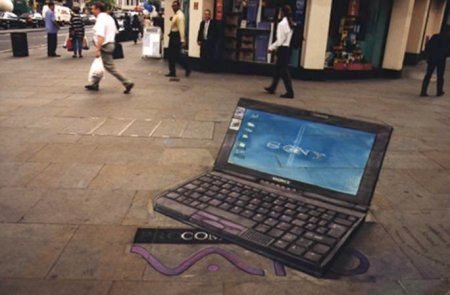 Drawn On A Flat Sidewalk With Colored Chalk.
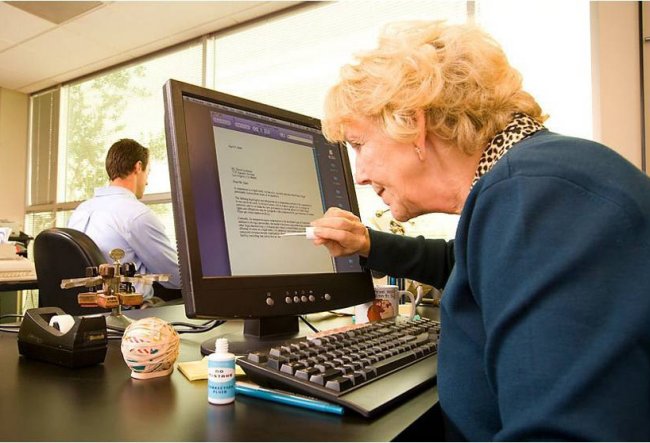
It Is Time To Retire.
Success In 1923 Who Was:
1. President of the largest steel company?These men were considered some of the world's most successful of their days. Now, 76 years later, the history book asks us, if we know what ultimately became of them. The Answers:
1.The president of the largest steel company. Charles Schwab, died a pauper.However, in that same year, 1923, the PGA Champion and the winner of the most important golf tournament, the US Open, was Gene Sarazen. What became of him? He played golf until he was 92, died in 1999 at the age of 95. He was financially secure at the time of his death.
The Moral: Play golf.
A Redneck Bar-B-Que Grill
WIFE: What would you do if I died? Would you get married again? HUSBAND: Definitely not!. WIFE: Why not? Don't you like being married? HUSBAND: Of course I do. WIFE: Then why wouldn't you remarry? HUSBAND: Okay, okay, I'd get married again. WIFE: You would? (with a hurt look) HUSBAND: (makes audible groan). WIFE: Would you live in our house? HUSBAND: Sure, it's a great house. WIFE: Would you sleep with her in our bed? HUSBAND: Where else would we sleep? WIFE: Would you let her drive my car? HUSBAND: Probably, it is almost new. WIFE: Would you replace my pictures with hers? HUSBAND: That would seem like the proper thing to do. WIFE: Would you give her my jewelry? HUSBAND: No, I'm sure she'd want her own. WIFE: Would you take her golfing with you? HUSBAND: Yes, those are always good times. WIFE: Would she use my clubs? HUSBAND: No, she's left-handed. WIFE: -- silence -- HUSBAND: Damn.
|
|
All material in this site may be used to educate everyone, Freemasons and non-Freemasons alike about Freemasonry and for the promotion of Freemasonry. A very sincere effort is made to avoid using any copyrighted material, without permission or giving credit to the author and source, in the creation of this web site. If you discover something that is yours, without giving you due credit, please let me know and due credit will be given or the item will be replaced.
|
|
|

